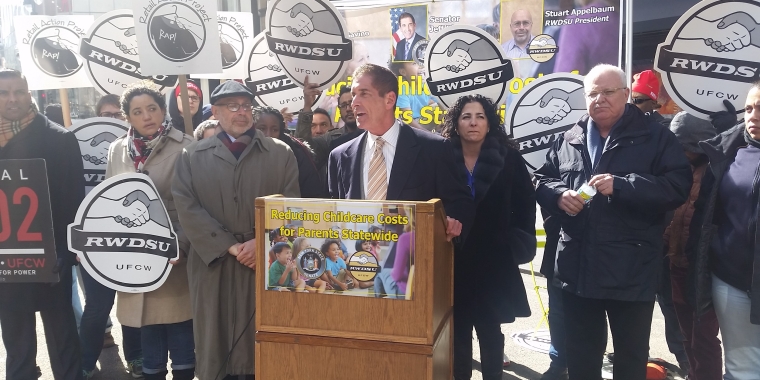
Independent Democratic Conference Releases Report Outlining Solutions to Address Financial Hardships of New York’s Seniors
Jeffrey D. Klein
February 10, 2015
IDC “Invest NY” Plan Aims to Expand Senior Housing Options and Enhance Consumer Protections Against Rising Utility Costs
ALBANY, NY – Today, Independent Democratic Conference Leader Jeff Klein and fellow IDC members released an extensive report outlining the financial obstacles facing New York’s senior population. In order to help make life more affordable for seniors, the IDC unveiled a litany of proposals that include a new senior utility circuit breaker program that will save taxpayers millions, the creation of a utility consumer advocate to fight unscrupulous rate increases, and plans to tackle the affordable housing crisis for seniors by constructing new developments all across the state. As a cornerstone of the IDC’s Invest NY plan, finding solutions to these problems are paramount in order to promote stability and financial security for all New York seniors.
In order to fully gauge the financial hardships facing elderly New Yorkers, the IDC also announced the launch of its brief and anonymous Senior Affordability Survey -- www.IDCInvestNY.com -- which will enable residents throughout the state to document their challenges in meeting the rising costs of homeowner expenses, property taxes, maintenance, utility bills, and other living expenses.
Independent Democratic Conference Leader Jeff Klein (D-Bronx/Westchester) said: “We have a responsibility to the generations that have come before us to lay a foundation of financial security and provide them the opportunity to thrive in their Golden Years. There clearly is a disconnect between reaching this goal and the current reality we face today. Now is the time to usher the resources at our disposal and invest in a long-term framework that will reduce living costs and provide real long-term relief I am confident that the proposals outlined today will begin to turn the tide and bring greater prosperity and independence for those living out their retirement years.”
While the current population of New Yorkers age 65 and older is estimated at 2.9 million, it is expected by 2040 a total of 4.6 million seniors will be living in New York State. Roughly 562,000, or nearly one out of every five seniors, live under 150% of the poverty line. In the absence of federal social security benefits, over 42% of New York’s seniors would live below the poverty line right now ($11,490/one person). In New York City the numbers are even worse, with 22% of seniors living at or below the federal poverty line, even with social security at their disposal.
Senator Diane Savino (D-Staten Island/Brooklyn) said: “It’s clear to see the issues concerning our senior population have been overlooked for way too long and its time we put them back at the forefront. We have an obligation to ensure that these men and women, who have worked hard throughout the years, can sustain their way of life without the financial uncertainty that so many of our seniors living here in New York struggle with. With the proposals outlined today, it is my hope that we will be able to increase not only the longevity of our more seasoned New Yorkers, but their livelihoods as well. For when you are no longer burdened with the thought of how you’re going to pay your bills during retirement, it gives you the opportunity to actually enjoy the fruits of your labor and that’s exactly what we want to make sure our seniors can do."
Senator David Carlucci (D-Rockand/Westchester) said: "We need to focus on real solutions that will allow our seniors to age gracefully, with dignity and respect. This agenda is committed to lowering energy costs, increasing supportive services and providing more affordable housing. Every senior struggling to stay in their home is someone’s parent or grandparent, and it’s time for New York State to do more."
Senator David Valesky (D-Oneida) said: "As costs go up, seniors living on a fixed income feel the effects exponentially. Our IDC proposals will provide relief from some of the most burdensome costs on seniors, including home repair, utilities and housing, with the goal of giving seniors additional financial flexibility they need to live safely and independently."
Senator Tony Avella (D-Queens) said: “Having fought for our seniors during my tenure both in the City Council and State Senate, I know firsthand the difficulties that seniors face day in and day out. For many, retirement has become a dream delayed, while others are forced to tackle the tough choices that come of living on a fixed income. New York’s seniors deserve better. With Invest New York’s Senior Platform, we will work to ensure that our seniors receive the rising cost-of-living relief and support that they deserve. Each of the six points laid out will ensure that we are working towards making New York affordable for those that need it most.”
To address this fundamental disconnect between affordability and the current cost of living, the IDC has laid out the following six policy recommendations to bridge this widening gap:
Senior Housing Development Fund
One of the ways the IDC believes it can protect seniors is by making critical investments in new senior housing developments. New York’s housing stock happens to also be the oldest in the nation, with the median age of a housing unit standing at 57 years old. Many older New Yorkers today are subsequently left with outdated housing that needs to be improved to accommodate senior needs. New senior housing would also provide the necessary transportation services, socials paces, and support maintenance that is needed to live and maintain one’s independence.
With the creation of a Senior Housing Development Fund, this would provide the necessary capital funding in the form of grants, similar to section 202, to developers looking to build housing restricted to individuals over 62 years of age. The IDC proposal is to set aside $40 million this year into this fund and would be tailored to those seniors classified as having moderate incomes.
NORC Program Expansions
As more seniors choose to age in place rather than relocate to retirement communities, the state must continue to address the phenomenon of Naturally Occurring Retirement Communities (NORC), allowing elderly residents to age in place and stay in their own homes. Data from surveys, as well as the IDC Senior Affordability Survey shows that seniors prefer to age in place rather than relocate to a care facility.
As such the IDC proposes an expansion of the NORC Supportive Service Program and Neighborhood NORC Program by allocating an additional $5 million to each annually. This will drastically increase the number of seniors who have the support they need to remain in their own homes and ensure not-for-profit organizations have access to the funding they need to provide services in housing, health or human services.
REPAIR 2015 Program
For those seniors who wish to remain to live in their homes, the costs of repairs and home improvements can be daunting. While many seniors would see added benefits to their health and safety if installations were made for such devices as ramps, handrails, lowered light switches and widened doorways, many simply cannot afford to pay for it on a fixed income.
In order to address this dilemma, the IDC proposes REPAIR 2015, which would create a tax credit of up to $7,500 available directly to seniors for repair to their home that improve the health and safety of the senior. This would be funded at a cost of $5 million and make it available in 2016, allowing those filing tax returns in the next cycle to take immediate advantage.
The IDC also seeks to create an expansion of the existing New York State Residential Emergency Services to Offer (Home) Repairs to the Elderly program -- commonly referred to as RESTORE -- which would target homeowners directly and allow both low-and-middle-income seniors to share in the benefits. RESTORE is a vital program that assists seniors in paying for expensive and necessary repairs and ensures funding for not-for-profits to conduct needed assistance.
Senior Utility Circuit Breaker
In order to address this crushing costs of utility expenses, the IDC proposes a senior utility circuit breaker that would provide a senior household with relief equal to half of their expenses above the seven percent threshold. Covered expenses would include electricity charges, gas, heating charges, water and sewer charges, internet as well as telephone charges.
Utility Consumer Advocate
As outlined by Senator Diane Savino’s Senate Bill (S.4550) of 2014, the IDC calls for the creation of an independent statewide Utility Consumer Advocate charged with ensuring that the public, including our struggling seniors, receives the consideration it deserves from New York’s utility-rate-setting bodies. This would ensure there is an independent voice at the table when regulated utilities ask for a rate increase.
Department of Motor Vehicles Discount
Finally, the IDC calls for a senior discount related to costs associated at the Department of Motor Vehicles when individuals register their vehicles with the DMV and then re-register the car on a regular eight-year cycle. The proposal equates to a 10% discount to senior citizens at least 65 years of age for their transactions with the DMV.
Bobbie Sackman, Director of Public Policy, LiveOn NY said: "On behalf of older adults throughout the state, LiveOn NY is greatly appreciative that the IDC continues to pay close attention to the needs of the most rapidly growing population in New York. We are particularly pleased that the IDC has focused on housing for both low income and middle income older adults. Affordability is the cornerstone for seniors to age in place in their homes and communities which is what they want to do. LiveOn NY looks forward to working with state partners to ensure that older New Yorkers can age with grace, confidence and vitality in the communities they've lived in and supported over their lifetime."
Laura Cameron, Executive Director of the Association on Aging in New York said: “We support the Independent Democratic Conference’s (IDC) Senior Relief Package which includes measures to assist seniors that are facing increased costs while living on a fixed income. Every day in New York State, seniors and their caregivers reach out to our offices for aging for services and assistance. The demand for services will continue to escalate, fueled by a growing senior population, and we support initiatives that make it possible for more older residents to remain in their homes and communities as they get older.”
“AARP would like to commend the leadership of Senator Klein, and the members of the Independent Democratic Conference for proposing this agenda that invests in New York's 50-plus population,” said Beth Finkel, State Director for AARP in New York. “Affordable housing and the ability to pay your utility bill are key issues that need to be addressed in our state. Creating an utility consumer advocate with the independence to pursue the best course for ratepayers is long over due and the IDC’s proposal would be a game-changer when rate hikes go before regulators.”
Gail Myers, Deputy Director, NY StateWide Senior Action Council, said: "NY StateWide Senior Action Council is so pleased that the IDC has listened to the concerns of their constituency and created a policy agenda to continue last year’s work to reduce the financial burden older New Yorkers face. The expansion in 2014 of the Elderly Pharmaceutical Insurance Coverage Program relieved a major stressor – the out of pocket costs of prescription drugs. The IDC focus on affordable housing, utility tax relief, assistance with the cost of home repairs and housing based services and supports provided through an expansion of the Naturally Occurring Retirement Communities model will allow seniors to continue to live and contribute to the fabric of their communities, something that is good for all of us.”
Share this Article or Press Release
Newsroom
Go to Newsroom
SENATOR KLEIN HOSTS 21ST ANNUAL BLACK HISTORY MONTH
February 22, 2016

INDEPENDENT DEMOCRATIC CONFERENCE LAUNCHES SENIORS FIRST INITIATIVE
February 22, 2016
